Recently I got in trouble for expressing my personal opinion on choke chains. I know there are trainers who express their beliefs and opinions more aggressively but that’s just not my personality. I don’t know what has gotten into me that day. I learned two lessons from that incident.
First, I should never have bashed it the way I did as bashing only makes people angry and defensive. Second, I lost an opportunity to show an “old-school trainer” the other ways to train dogs.
Just as I give dogs options during training, I usually give my students variety of options. I suggest ideas but never force them do that because the owners have to feel good about what they are doing. I spend extra time demonstrating the training gear that I think are dog friendly (and family friendly) and luckily most of them like the idea of being “gentle” and “kind” to their dogs.
Here’s some of my preferred training gear and why. I like the ones that are as comfortable to the dogs as possible. My job as a pet dog training instructor is to educate and guide the owners. The rest is up to them. Just remember, any tools can be abusive to dogs if used in such ways. But if a tool is designed to stop a behavior because it gives pain, then you might want to re-think about what it is doing to your dog.
- There are variety of front clip harnesses these days. I never really use them on my
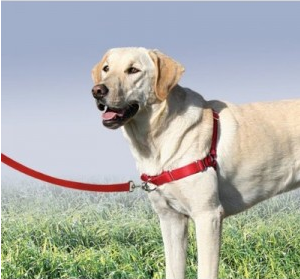 dogs/foster dogs but this is my #1 recommendation for large dogs that take pulling seriously. Most pet owners want quick fix. And this is one of them. Well, it doesn’t necessary “fix” the problem but it makes the walking less frustrating while you work on the actual leash walking on the side. The easy walk harness by premiere is the most available around here. But I like the one from wags and wiskers. It fits better than easy walk and it has extra padding around the “arm pits”.
dogs/foster dogs but this is my #1 recommendation for large dogs that take pulling seriously. Most pet owners want quick fix. And this is one of them. Well, it doesn’t necessary “fix” the problem but it makes the walking less frustrating while you work on the actual leash walking on the side. The easy walk harness by premiere is the most available around here. But I like the one from wags and wiskers. It fits better than easy walk and it has extra padding around the “arm pits”. - I use regular harness with a clip on the back (or you can flip the easy walk harness around) on small dogs to protect their trachea. I also use them on my dogs when we go to the pond. If anything happens, I can grab them quickly. I also use it initially on foster dogs that are head shy. On pullers, regular harnesses can encourage the dogs to pull harder. Picture sled dogs and trailing dogs.
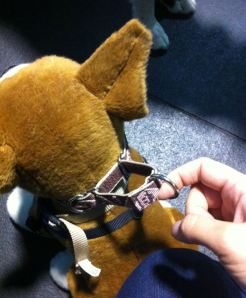
- I use fabric martingale collar with a buckle on all my fosters. I don’t use them for training purpose but for safety. It is a non-slip collar that is designed to prevent a dog from slipping out. This collar must be fitted correctly or your dog can still slip out or his paw can get stuck in the extra loop. When you pull the small loop, there should be 1-2 inches between the two metals. (See image) I like the one with a plastic buckle like this one. If a dog is timid, slipping a collar over his head can be scary to him.
- Gentle leader is not my first choice and I rarely use it but I have recommended to
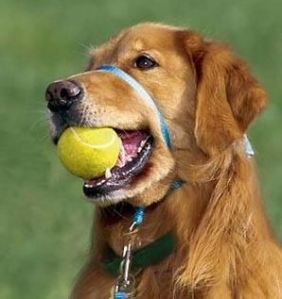 some dog owners if they are willing to spend few weeks to get the dogs used to wearing it. If used incorrectly, it can irritate dog’s eyes, muzzle and neck. You can get the ones with soft padding underneath it for added comfort.
some dog owners if they are willing to spend few weeks to get the dogs used to wearing it. If used incorrectly, it can irritate dog’s eyes, muzzle and neck. You can get the ones with soft padding underneath it for added comfort. - Tags – I either put silencer on dog tags or use non-metal tags like this one. It helps with my neighbor’s dogs who react to tag noises. I also find the jingling noises rather annoying!
Leashes

- I have tried 30+ different leashes and my current favorite is 6 foot-long biothane bright colored leash. If a dog pees on it, you can simply wash it off. After a few weeks of wear, it fits nicely in my hands and it is easy to find when left on the ground.
- I have several fabric long lines but my favorite is biothane long line for the same reason. Fabric ones burn your hands and it gets stinky quickly.
- Leash tab can be useful at agility practice, camping or at off leash training classes.
- Retractable leash is NOT my favorite but I have to make some comments. I could write another blog post about my dislike for retractable leashes! First of all, the line is always tight. Your dog will never learn not to pull on leash. My biggest problem with retractable leash is what it does to other dogs. Your dog on an extended retractable leash might love all dogs but the other dog your dog approaches might not. I had to step in at a vet’s office when a little puppy on a retractable leash continued to jump and bounce on a clearly (to me at least) uncomfortable Mastiff. The owner of the puppy thought it was funny. It wouldn’t be funny when the Mastiff could no longer tolerate the rudeness anymore. And who will get punished? Sadly, the Mastiff, right? I still have a retractable leash and I do use it time to time. It helped when I had a very fearful foster who wouldn’t go potty in the backyard and was afraid of a long line following him behind. I’ve used it on an escape artist who continued to pee and poop on his drag line.
Clickers
- My favorite one is iClicker from Karen Pryor. It’s not too loud and you can

click it with your foot when you got your hands full.
Other optional tools
- Herding whistle – I have one in my car, one in my purse, one in the house and
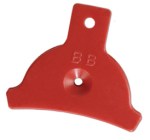 several other places in case I need it. I don’t go anywhere without one. I used to own an expensive brass whistle but I didn’t like the feel/taste of it. I now use the cheap plastic kind from bordercollies.com. It can take some time to get a sound out. Practice in the car while you are in traffic!
several other places in case I need it. I don’t go anywhere without one. I used to own an expensive brass whistle but I didn’t like the feel/taste of it. I now use the cheap plastic kind from bordercollies.com. It can take some time to get a sound out. Practice in the car while you are in traffic! - Manners minder – I have two. First one died within a week. The second one is still breathing but food gets jammed often. There is a similar one from Clean run. I have never used it personally.
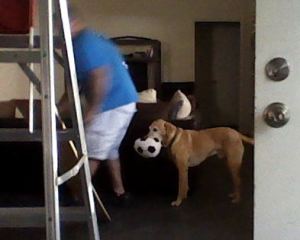
 its mouth to defend himself, it is only kind to get him conditioned to wearing a muzzle BEFORE taking him to the vet or other stressful environment. Basket muzzles look intimidating but it is much more comfortable to the dogs. For a short period of time, you can use a fabric muzzle.
its mouth to defend himself, it is only kind to get him conditioned to wearing a muzzle BEFORE taking him to the vet or other stressful environment. Basket muzzles look intimidating but it is much more comfortable to the dogs. For a short period of time, you can use a fabric muzzle.I know I’m forgetting something…I’ll continue to add as I think of more. Any other tools/gear you like?




I was just thinking what sort of collar/leash I should bring Maverick on to my training session tonight. I am guilty of using choke chains. More and more recently I’ve been searching for other options, because I do realize that just aren’t kind. To be fair, I try my hardest to use it as it was intended at the very top of the neck and avoid yanking and choking. However, I love just being able to slip them over their heads for a quick potty break.
If a dog has any reactivity issue, I usually recommend harnesses. A lot of time these dogs get intentionally or unintentionally corrected by the collar when they see other dogs/people because they react by lunging and barking. The pressure on the neck can increase frustration and sometimes fear/pain. When you switched to a harness, it’s a whole new sensation and there is less negative association. Since it’s mostly for an assessment, bring him on a choke chain today but also leave his regular collar or harness on (if you have one). For a quick slip on, I like to use a slip lead you see at the boarding facility/vet and shelters. I have an extra you can take.
Makes sense! I always leave his regular collar on because it has his tags!!!! We’ll see you tonight!! :)